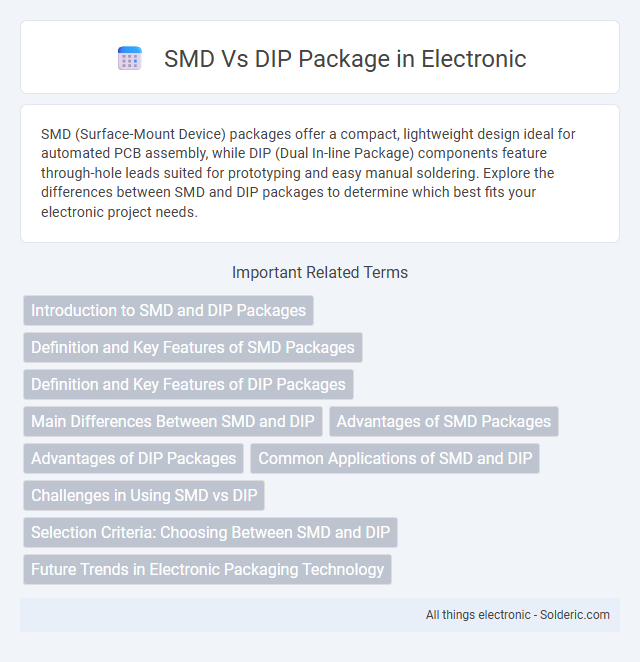SMD (Surface-Mount Device) packages offer a compact, lightweight design ideal for automated PCB assembly, while DIP (Dual In-line Package) components feature through-hole leads suited for prototyping and easy manual soldering. Explore the differences between SMD and DIP packages to determine which best fits your electronic project needs.
Comparison Table
| Feature | SMD (Surface-Mount Device) | DIP (Dual In-line Package) |
|---|---|---|
| Mounting | Mounted directly on PCB surface | Inserted through PCB holes |
| Size | Smaller, compact design | Larger, bulkier |
| Assembly | Automated, faster pick-and-place machines | Manual or automated insertion |
| Performance | Better high-frequency performance | Lower frequency applications |
| Repair & Prototyping | Harder to rework or replace | Easier manual replacement and prototyping |
| Cost | Generally lower production costs | Higher costs due to manual labor |
| Common Use | Modern consumer electronics, smartphones | Through-hole designs, DIP sockets for ICs |
Introduction to SMD and DIP Packages
SMD (Surface-Mount Device) packages are compact electronic components designed for mounting directly onto the surface of printed circuit boards (PCBs), enabling higher component density and automated assembly. DIP (Dual In-line Package) components feature two parallel rows of pins that are inserted into through-holes on PCBs, offering robust mechanical connections and ease of prototyping. Both SMD and DIP packages play critical roles in electronic design, balancing factors such as size, manufacturing complexity, and application requirements.
Definition and Key Features of SMD Packages
Surface Mount Device (SMD) packages are compact electronic components designed for direct mounting on the surface of printed circuit boards (PCBs), enabling high-density circuit assembly. Key features of SMD packages include smaller size, reduced lead inductance, and improved electrical performance compared to traditional Dual In-line Package (DIP) components. These advantages facilitate automated manufacturing processes and contribute to the miniaturization of electronic devices.
Definition and Key Features of DIP Packages
DIP (Dual Inline Package) is a type of electronic component packaging featuring two parallel rows of pins extending perpendicularly from a rectangular housing, designed for through-hole mounting on printed circuit boards (PCBs). DIP packages are known for their ease of manual assembly, durability, and straightforward soldering process, making them ideal for prototyping and educational use. Key characteristics include standardized pin spacing, robust physical connection, and compatibility with legacy equipment in electronics manufacturing.
Main Differences Between SMD and DIP
Surface Mount Device (SMD) packages are significantly smaller and designed for automated assembly on the surface of PCBs, enabling higher component density and faster manufacturing. Dual In-line Package (DIP) components feature through-hole pins that insert into PCB holes, providing ease of manual soldering and durability in prototyping and repair. SMD packages excel in high-frequency applications due to reduced lead inductance, while DIP packages are favored for their mechanical robustness and simplicity in circuit testing.
Advantages of SMD Packages
SMD packages offer significant advantages including smaller size, which enables higher component density and more compact circuit designs compared to DIP packages. Their automated assembly process reduces manufacturing costs and improves production speed while enhancing electrical performance due to shorter lead lengths. Enhanced thermal management and better mechanical reliability further contribute to SMD's widespread adoption in modern electronics manufacturing.
Advantages of DIP Packages
DIP (Dual In-line Package) offers advantages like easy manual soldering and straightforward prototyping, making it ideal for hobbyists and initial circuit design. Its through-hole mounting provides strong mechanical bond and durability, which is beneficial in environments subject to vibration or physical stress. You can quickly replace or test individual components without specialized equipment, easing maintenance and debugging processes.
Common Applications of SMD and DIP
SMD (Surface-Mount Device) packages are commonly used in compact, high-density electronic devices such as smartphones, laptops, and wearables due to their small size and automated assembly efficiency. DIP (Dual In-line Package) components find frequent application in prototyping, through-hole PCB designs, and devices requiring manual soldering or easy replacement, including microcontrollers and larger power transistors. Both package types support varied applications, with SMD dominating modern consumer electronics and DIP prevalent in educational kits and industrial equipment.
Challenges in Using SMD vs DIP
Surface Mount Device (SMD) packages present challenges including difficulties in manual soldering due to their small size, requiring precise equipment and skills, while Dual Inline Package (DIP) components offer easier handling and soldering for prototypes or low-volume production. Thermal management is more complex in SMDs as their compactness limits heat dissipation, contrasting with DIPs that provide better airflow and cooling opportunities. Inspection and testing of SMD assemblies can be problematic without specialized tools, whereas DIPs allow straightforward visual inspection and rework.
Selection Criteria: Choosing Between SMD and DIP
Selecting between SMD (Surface-Mount Device) and DIP (Dual Inline Package) hinges on factors such as board space, assembly method, and performance requirements. SMD components offer compact size and suitability for automated assembly, ideal for high-density and mass production applications. DIP packages provide ease of manual handling and prototyping, favored in development phases and through-hole PCB designs where mechanical robustness is required.
Future Trends in Electronic Packaging Technology
Future trends in electronic packaging technology emphasize the shift from dual in-line package (DIP) to surface-mount device (SMD) packages due to their smaller footprint, higher component density, and improved thermal performance. Advanced SMD innovations showcase enhanced miniaturization, multi-layer PCB integration, and automated assembly processes that drive better signal integrity and power efficiency. Emerging techniques such as 3D packaging and system-in-package (SiP) leverage SMD advantages to support the growing demand for compact, high-speed consumer electronics and IoT applications.
SMD vs DIP package Infographic

 solderic.com
solderic.com